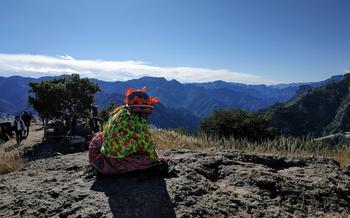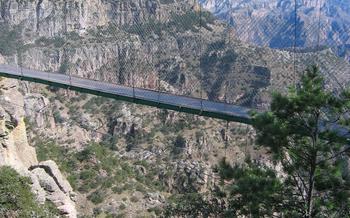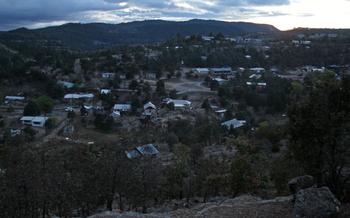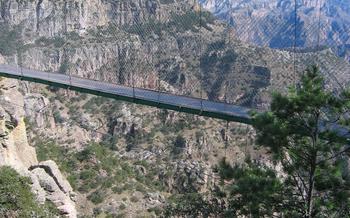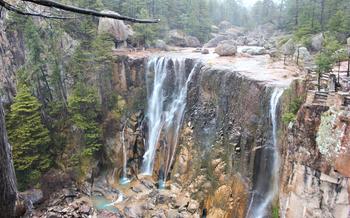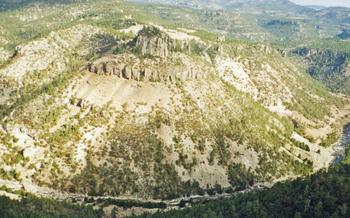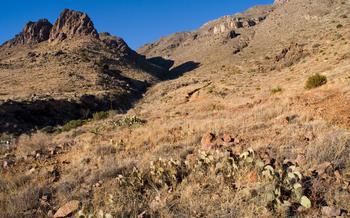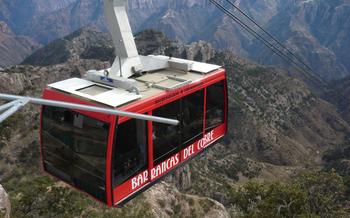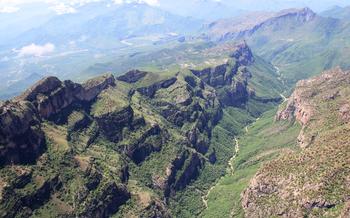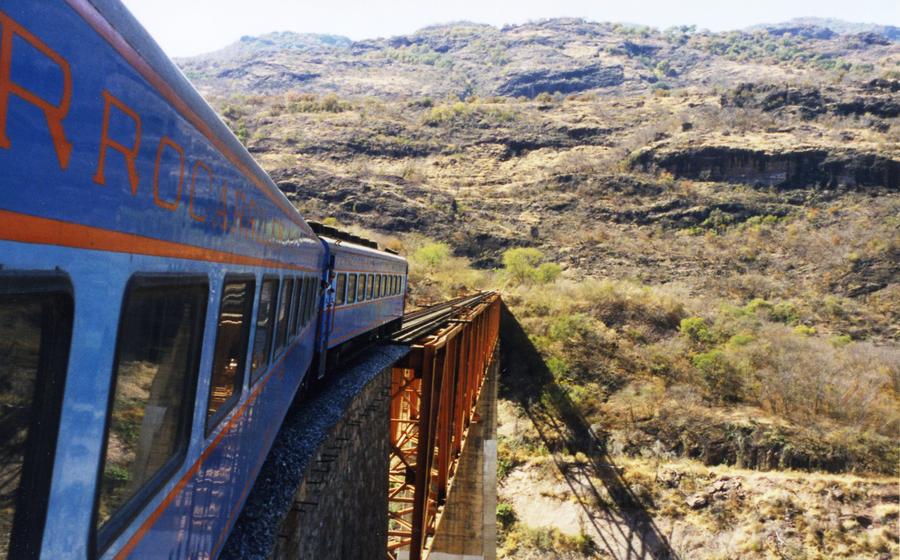
Cumbres de Majalca National Park
- Copper Canyon: A Natural Wonder
- Cumbres de Majalca National Park: An Oasis in the Desert
- Getting There: An Adventure in Itself
- Accommodation: A Range of Options
- Food: A Culinary Delight
- Activities: Adventure and Relaxation
- The Copper Canyon Train: A Journey Through Time
- The Tarahumara People: Guardians of the Land
- Photography: Capturing the Beauty
- Safety: A Peaceful Destination
- Souvenirs: Unique Treasures
- Budget: Planning for Your Trip
- Off-the-Beaten-Path Experiences
- Responsible Tourism: Treading Lightly
- Insider Tip: Unveiling a Secret Spot
Copper Canyon: A Natural Wonder
The Copper Canyon, also known as Barrancas del Cobre, is a system of canyons located in the southwestern part of the Mexican state of Chihuahua, specifically in the Sierra Madre Occidental mountain range. This impressive natural formation is often compared to the Grand Canyon in the United States due to its sheer size and breathtaking views. The Copper Canyon is actually comprised of six distinct canyons, each one named for a different town or landmark in the area. The largest of these canyons is the Urique Canyon, which reaches a depth of over 1,800 meters (5,900 feet), making it one of the deepest canyons in the world.
The Copper Canyon is a product of millions of years of geological activity, as the relentless forces of wind and water carved deep into the landscape. The result is a series of rugged cliffs, sheer rock faces, and lush canyons that are home to an incredible diversity of flora and fauna. The canyon walls are composed of a variety of sedimentary and volcanic rocks, giving them a distinctive reddish-brown hue that gives the region its name.
The cultural significance of the Copper Canyon is profound, as it has been inhabited by indigenous peoples for centuries. The most notable of these groups are the Tarahumara people, also known as the Rarámuri, who have lived in the region for over a thousand years. The Tarahumara have a rich culture and traditions that are closely tied to the land and its natural resources. They are renowned for their long-distance running abilities and their intricate handicrafts, which are often inspired by the beauty of the canyons.
Cumbres de Majalca National Park: An Oasis in the Desert
Nestled within the heart of Copper Canyon, Cumbres de Majalca National Park stands as a testament to the region's diverse and awe-inspiring landscapes. This vast expanse of rugged mountains, lush forests, and cascading waterfalls encompasses a unique ecosystem that is home to a rich tapestry of flora and fauna.
The park's geographical location, situated at the convergence of three distinct ecosystems - the Sierra Madre Occidental, the Sonoran Desert, and the Chihuahuan Desert - has fostered an extraordinary biodiversity. Visitors can marvel at the towering Ponderosa pines and Douglas firs that blanket the mountain slopes, providing a stark contrast to the arid plains below. The park's diverse plant life includes over 1,000 species, including rare and endangered cacti, succulents, and wildflowers that bloom in vibrant hues during the spring.
Cumbres de Majalca National Park is also a haven for wildlife. The park's diverse habitats support a variety of animal species, including black bears, cougars, bobcats, deer, and a diverse array of bird species. The park's rivers and streams are home to a variety of fish, including trout and bass, while the skies above are often filled with the soaring silhouettes of majestic eagles.
Beyond its natural beauty, Cumbres de Majalca National Park holds immense historical and cultural significance. The park is home to numerous archaeological sites, including ancient cave dwellings and rock art, which provide glimpses into the region's rich indigenous heritage. The park is also home to several Tarahumara communities, who have lived in harmony with the land for centuries and continue to maintain their traditional way of life.
Getting There: An Adventure in Itself
The journey to Cumbres de Majalca National Park is an adventure in itself. Located deep within the rugged Copper Canyon, the park is accessible by various transportation options. For those seeking a scenic and immersive experience, the Chihuahua al Pacífico train, also known as El Chepe, offers a unique way to traverse the canyon. This iconic train meanders through breathtaking landscapes, passing through tunnels and over bridges, providing a glimpse into the region's rich history and natural beauty.
For those with limited time or seeking a more flexible option, buses and private vehicles are also available. Buses depart from major cities in the region, such as Chihuahua and Los Mochis, and offer a comfortable and affordable way to reach the park. Renting a car allows for greater freedom and flexibility, enabling travelers to explore the surrounding areas at their own pace.
The duration of the journey varies depending on the chosen transportation method and the starting point. From Chihuahua, the train ride takes approximately 15 hours, while the bus journey takes about 12 hours. Driving by car from Chihuahua takes about 8 hours, offering the opportunity to stop at various points of interest along the way.
To ensure a smooth and enjoyable trip, it is advisable to plan ahead and book transportation in advance, especially during peak tourist season. It is also important to be prepared for delays and unforeseen circumstances, as weather conditions and road closures can occasionally affect travel plans.
Accommodation: A Range of Options
The Cumbres de Majalca National Park offers a range of accommodation options to suit every budget and preference. From luxurious hotels and resorts to rustic cabins and lodges, there is something for every traveler.
For those seeking a comfortable and convenient stay, hotels and resorts offer a range of amenities, including swimming pools, restaurants, and spas. These properties are often located near the park's main attractions, making it easy to explore the area.
For a more immersive experience, cabins and lodges provide a cozy and intimate setting. These accommodations are typically located within the park itself, offering stunning views and easy access to hiking trails and other activities.
For those on a tight budget, camping facilities are available within the park. These campgrounds offer basic amenities, such as restrooms and showers, and provide a great opportunity to connect with nature.
When choosing your accommodation, consider your budget, the level of comfort you desire, and the activities you plan to do. With careful planning, you can find the perfect place to stay that will enhance your visit to the Cumbres de Majalca National Park.
Food: A Culinary Delight
The Copper Canyon region boasts a rich and diverse culinary scene, tantalizing the taste buds of visitors with a blend of traditional Mexican flavors and unique local specialties. From cozy restaurants and cafes to street stalls and markets, there are plenty of options to satisfy every palate.
Traditional Mexican cuisine takes center stage, with dishes like tacos, burritos, and enchiladas showcasing the vibrant flavors of the region. Local specialties, such as the iconic dish "carne asada" (grilled beef) and the hearty "pozole" (a hominy-based soup), are must-try delicacies that reflect the region's culinary heritage.
For those seeking a taste of the local culture, cooking classes offer an immersive experience, allowing visitors to learn the art of preparing traditional Mexican dishes using fresh, locally sourced ingredients. Whether it's mastering the perfect salsa or creating mouthwatering enchiladas, these classes provide a unique opportunity to connect with the region's culinary traditions.
As you savor the flavors of Copper Canyon, remember to stay hydrated, especially in the warm and dry climate. Local beverages like "agua fresca" (fresh fruit water) and "tejate" (a traditional fermented corn drink) are refreshing and authentic choices to quench your thirst.
Activities: Adventure and Relaxation
The Cumbres de Majalca National Park offers a wide range of activities for visitors seeking adventure and relaxation. Whether you're an avid hiker, a thrill-seeker, or simply looking to soak up the beauty of nature, you'll find something to suit your interests.
Hiking Trails: The park boasts an extensive network of hiking trails, ranging from easy walks to challenging treks. Explore the diverse landscapes, from lush forests to towering canyons, while enjoying breathtaking views and spotting native wildlife.
Mountain Biking: Embark on a mountain biking adventure through the park's rugged terrain. Discover hidden trails, conquer steep climbs, and enjoy exhilarating descents. Mountain bike rentals are available at the park entrance.
Rock Climbing: For those seeking a vertical challenge, the park offers numerous rock climbing routes for all skill levels. Scale towering cliffs, tackle bouldering challenges, and enjoy the panoramic views from the top.
Horseback Riding: Experience the park on horseback and explore the hidden trails and scenic vistas inaccessible by foot. Guided horseback riding tours are available for both beginners and experienced riders.
Wildlife Watching: The park is home to a diverse array of wildlife, including birds, mammals, and reptiles. Embark on a wildlife-watching safari to spot elusive creatures like the Mexican wolf, black bear, and golden eagle.
The Copper Canyon Train: A Journey Through Time
Climb aboard the iconic Copper Canyon Train and embark on a journey through time. This legendary railroad, constructed in the early 20th century, has played a pivotal role in the region's history and development. Originally built to transport minerals from the mines of the Sierra Madre Mountains, the train now serves as a vital link between the towns and villages of the Copper Canyon, providing a unique and unforgettable travel experience.
The route of the Copper Canyon Train is a masterpiece of engineering, winding its way through breathtaking landscapes, crossing towering bridges, and navigating narrow tunnels carved into the sheer rock faces. Passengers are treated to panoramic views of the canyon's rugged terrain, verdant valleys, and sparkling rivers, as the train chugs along at a leisurely pace, allowing ample time to soak in the scenery and capture stunning photographs.
A ride on the Copper Canyon Train is more than just a mode of transportation; it's an adventure in itself. The train's vintage cars, with their polished brass fittings and plush velvet seats, evoke a sense of nostalgia and transport passengers back to a bygone era. The friendly and knowledgeable staff are always ready to share stories about the region's history, culture, and the train's rich legacy, making the journey even more immersive.
To fully appreciate the beauty and significance of the Copper Canyon, a ride on the train is an absolute must. Whether you choose to travel the entire route or just a portion of it, the experience will leave an indelible mark on your memories.
Tips for Booking Tickets:
- Plan ahead and book your tickets well in advance, especially if you are traveling during peak season.
- Consider purchasing a first-class ticket for a more comfortable and exclusive experience.
- Be flexible with your travel dates to take advantage of discounts and promotions.
- Check the train's schedule carefully and plan your itinerary accordingly.
- Arrive at the train station at least 30 minutes before departure to ensure a smooth boarding process.
The Tarahumara People: Guardians of the Land
The Copper Canyon is home to the Tarahumara people, an indigenous group known for their deep connection to the land, their unique culture, and their incredible endurance. Often referred to as the "Running People" due to their remarkable ability to run long distances in rugged terrain, the Tarahumara have inhabited the region for centuries, living in harmony with the environment and preserving their ancestral traditions.
History and Culture: The Tarahumara, also known as the Rarámuri, have a rich history and culture that predates the arrival of the Spanish. They have a deep understanding of the natural world and a strong spiritual connection to the land, which they believe is sacred. Their culture is centered around community, cooperation, and respect for nature.
Traditions and Customs: The Tarahumara are renowned for their traditional clothing, which includes colorful woven blankets, skirts, and head coverings. They are also known for their intricate beadwork, pottery, and basketry. Their traditional music and dance are vibrant expressions of their cultural identity.
Interaction with Visitors: The Tarahumara are generally welcoming and friendly towards visitors, although they may be shy at first. They are proud of their culture and are happy to share it with those who are respectful and interested. Visitors can learn about Tarahumara traditions and customs by visiting their villages, attending local festivals, and interacting with them in a respectful manner.
Ethical Tourism Practices: When visiting the Copper Canyon, it is important to be mindful of the Tarahumara culture and to practice ethical tourism. This includes respecting their privacy, asking permission before taking photographs, and avoiding giving them money or gifts that may disrupt their way of life. Supporting local businesses and initiatives that benefit the community is also a great way to show respect and contribute to the preservation of their culture.
Photography: Capturing the Beauty
The Copper Canyon offers a stunning array of landscapes, from towering cliffs to lush forests, providing ample opportunities for photography enthusiasts to capture breathtaking images. The best time to take photographs is during the golden hours, just after sunrise and before sunset, when the light is warm and diffused, creating a magical glow.
For those seeking iconic shots, Mirador de Basaseachic, which offers panoramic views of the deepest canyon in Mexico, is a must-visit. The Copper Canyon Train journey also presents many photo opportunities, with the train winding through tunnels and crossing bridges against a backdrop of dramatic landscapes.
To capture the essence of the region, venture off the beaten path and explore the hidden corners of the canyon. Look for unique perspectives, such as photographing the Tarahumara people in their traditional attire or capturing the wildlife in its natural habitat.
If you're serious about photography, consider joining a photography tour led by an experienced guide who can take you to the best spots and provide tips on how to capture the perfect shot.
Remember to respect the environment and ask permission before photographing people or sacred sites. By following these guidelines, you can ensure that your photography experience in the Copper Canyon is both ethical and rewarding.
Safety: A Peaceful Destination
The Copper Canyon region is generally considered a safe destination for travelers. The local communities are welcoming and hospitable, and the crime rate is low. However, as with any travel destination, it's essential to take precautions to ensure your safety.
Here are some tips for staying safe in the Copper Canyon:
-
Be aware of your surroundings. This is especially important in crowded areas or when hiking or exploring remote areas.
-
Keep your valuables safe. Don't carry large amounts of cash or flash expensive jewelry.
-
Avoid walking alone at night. If you must walk alone, stick to well-lit areas and be aware of your surroundings.
-
Use licensed taxis or transportation services. Avoid getting into unmarked cars or accepting rides from strangers.
-
Be respectful of local customs and traditions. This will help you avoid misunderstandings or conflicts.
-
Learn a few basic Spanish phrases. This will help you communicate with locals and get around more easily.
-
Purchase travel insurance. Travel insurance can provide peace of mind and financial protection in case of unexpected events.
Solo travelers should take extra precautions, such as:
-
Informing someone about your travel plans and itinerary.
-
Staying in touch with friends or family while traveling.
-
Avoiding isolated areas or hiking alone.
By following these tips, you can help ensure a safe and enjoyable trip to the Copper Canyon.
Souvenirs: Unique Treasures
The Copper Canyon region is a treasure trove of unique and authentic souvenirs that reflect the rich cultural heritage of the area. From intricate handicrafts to locally produced ingredients, there's something for every traveler to cherish.
Handicrafts and Traditional Art
The Tarahumara people are renowned for their exquisite handicrafts, which showcase their deep connection to nature and their ancestral traditions. Hand-woven baskets, colorful textiles, and intricate pottery are just a few of the many items you can find in local markets and shops.
Local Products and Ingredients
The region is also known for its delicious local products, such as honey, cheese, and coffee. These products are made using traditional methods and often feature unique flavors that reflect the region's unique terroir.
Where to Find Authentic Souvenirs
To find authentic souvenirs, it's best to visit local markets and shops rather than tourist traps. The Mercado de Artesanías in Creel is a great place to start, as it offers a wide variety of handicrafts and local products.
Bargaining Tips
Bargaining is a common practice in Mexico, and it's perfectly acceptable to try to negotiate a better price for souvenirs. However, it's important to be respectful and fair in your negotiations.
Supporting Local Communities
By purchasing souvenirs from local artisans and businesses, you can help support the local economy and preserve the region's cultural heritage. This is a meaningful way to contribute to the sustainability of the Copper Canyon region.
Budget: Planning for Your Trip
The cost of your trip to Cumbres de Majalca National Park will depend on your travel style, the time of year you visit, and the duration of your stay. However, in general, it is possible to have a comfortable and enjoyable trip without breaking the bank.
Accommodation:
Accommodation costs can vary significantly depending on your preferences and budget. Hostels and guesthouses offer the most affordable options, while mid-range hotels and resorts provide more comfort and amenities. For a truly immersive experience, consider staying in a traditional Tarahumara village.
Food:
Food is generally inexpensive in Mexico, and Cumbres de Majalca National Park is no exception. You can easily find delicious meals for a reasonable price. Be sure to try local specialties such as enchiladas, burritos, and tacos.
Activities and Tours:
There are many activities and tours available in the park, ranging from guided hikes to horseback riding excursions. Prices vary depending on the activity and duration. However, there are plenty of free or low-cost activities to enjoy, such as hiking, birdwatching, and picnicking.
Transportation:
Transportation costs can be minimized by taking public transportation or renting a car. If you are on a tight budget, consider traveling during the off-season when prices are lower.
Budgeting Tips:
- Plan your trip in advance and book your accommodation and activities early to take advantage of discounts.
- Take advantage of free or low-cost activities, such as hiking, birdwatching, and picnicking.
- Cook your own meals instead of eating out every night.
- Travel during the off-season to avoid peak-season prices.
- Look for discounts and promotions offered by hotels, tour operators, and transportation companies.
Off-the-Beaten-Path Experiences
Beyond the well-known attractions, Copper Canyon offers a wealth of hidden gems for those willing to venture off the beaten path. Explore lesser-known trails that lead to secluded waterfalls or panoramic viewpoints that offer breathtaking vistas of the canyon. Immerse yourself in the local culture by attending traditional festivals and events, where you can witness vibrant performances, indulge in delicious local cuisine, and interact with friendly locals. Step into the lives of the Tarahumara people by visiting their remote villages, learning about their unique traditions, and supporting their community-based tourism initiatives. The true magic of Copper Canyon lies in these hidden corners and authentic experiences, waiting to be discovered by adventurous travelers.
Responsible Tourism: Treading Lightly
As travelers, we have a responsibility to minimize our impact on the environment and respect the local communities we visit. In Copper Canyon, this means being mindful of our actions and choices.
Reduce, Reuse, Recycle: - Minimize waste by carrying reusable water bottles, shopping bags, and containers. - Dispose of trash properly in designated bins or carry it out with you.
Support Local Businesses: - Choose locally-owned restaurants, hotels, and tour operators to support the local economy. - Buy souvenirs from local artisans and vendors to encourage traditional crafts.
Respect Local Customs: - Learn about local customs and traditions before your visit to avoid misunderstandings. - Dress modestly and behave respectfully in public places.
Protect the Environment: - Stay on designated trails to avoid disturbing wildlife and vegetation. - Do not litter or pollute water sources. - Respect wildlife and their habitats by observing them from a distance.
Cultural Sensitivity: - Be respectful of the Tarahumara people and their culture. - Ask permission before taking photos or videos of people or sensitive sites. - Learn a few phrases in the Tarahumara language to show your respect.
By following these principles, we can help preserve the beauty and integrity of Copper Canyon for future generations while contributing positively to the local community.
Insider Tip: Unveiling a Secret Spot
A Hidden Waterfall:
Nestled deeper into the heart of the Cumbres de Majalca National Park, a secret waterfall awaits those willing to venture off the beaten path. Hidden among lush vegetation and towering cliffs, this enchanting cascade tumbles into a crystal-clear pool, creating a serene and isolated haven. Take a refreshing dip in the cool water, soak up the sun on the smooth rocks, and immerse yourself in the tranquility of this hidden gem.
A Secluded Viewpoint:
For those seeking breathtaking panoramas, a secluded viewpoint offers unparalleled vistas of the Copper Canyon. Perched atop a rugged cliff, this viewpoint grants visitors a bird's-eye perspective of the sprawling canyons, verdant forests, and distant peaks. As the sun paints the horizon with vibrant hues, savor the tranquility of this hidden spot, far from the crowds and immersed in the breathtaking beauty of the natural world.
A Local Restaurant:
In the heart of the Tarahumara community, a local restaurant invites visitors to experience authentic flavors and warm hospitality. Run by a local family, this hidden gem serves traditional dishes prepared with fresh, locally sourced ingredients. Indulge in mouthwatering stews, handmade tortillas, and flavorful salsas while engaging with the friendly locals and immersing yourself in the vibrant culture of the region.
A Special Event:
If fortune smiles upon you, you might stumble upon a special event that showcases the rich cultural heritage of the Tarahumara people. From traditional dances and music performances to colorful festivals and ceremonies, these events offer a glimpse into the vibrant tapestry of their traditions. Embrace the opportunity to connect with the locals, learn about their customs, and witness the infectious joy and camaraderie that permeate these celebrations.
